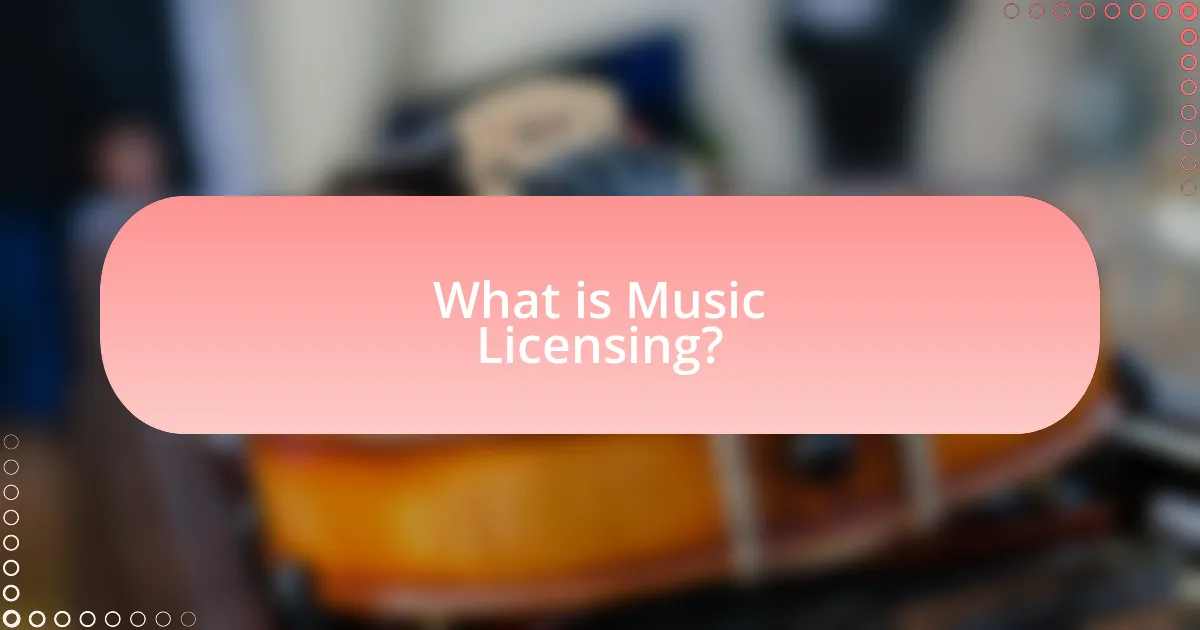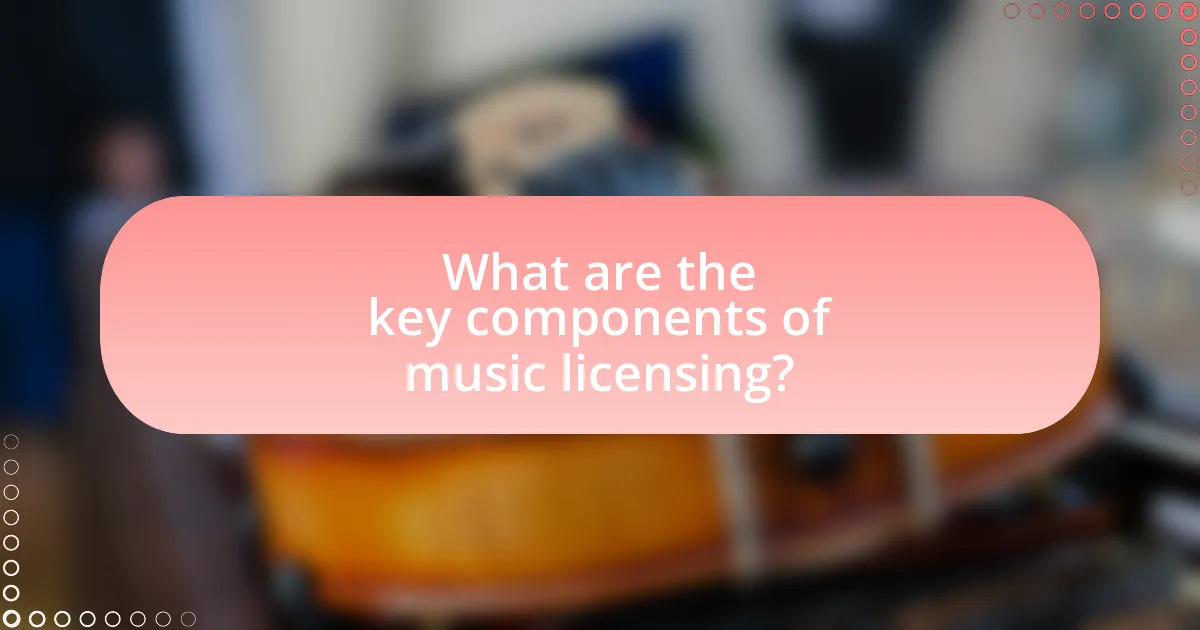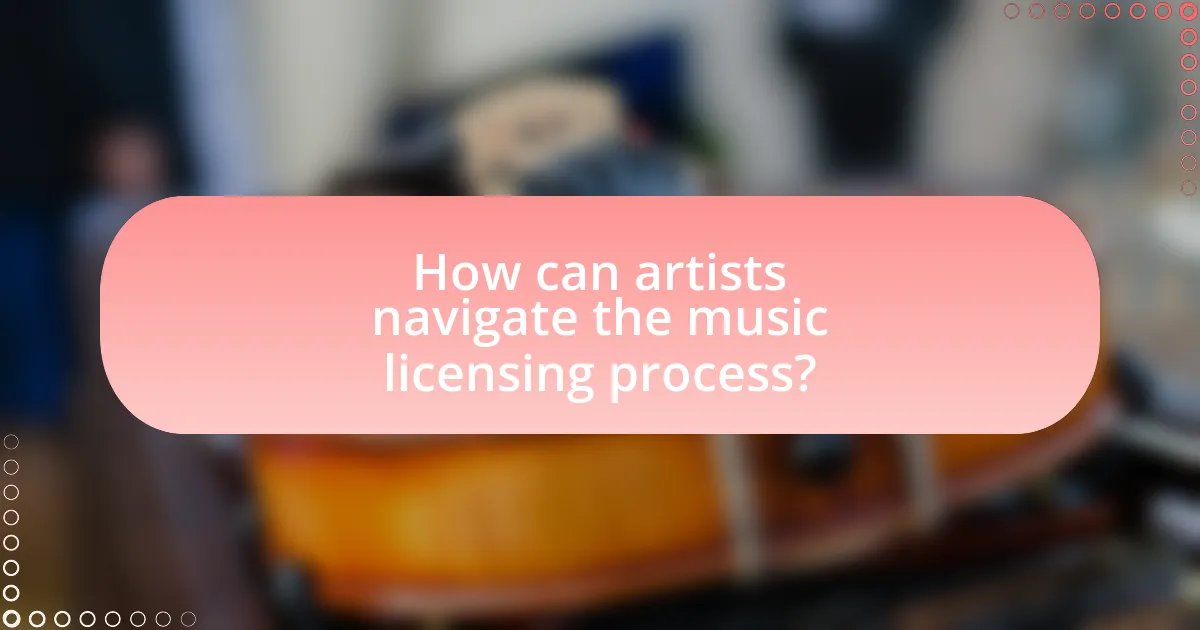Music licensing is the legal process of obtaining permission to use music in various media, ensuring that creators’ rights are respected and compensated. This article provides a comprehensive overview of music licensing, including its importance for new tracks, the different types of licenses available, and how licensing agreements protect artists. It also discusses the roles of performance rights organizations, the risks of operating without proper licensing, and best practices for artists to navigate the licensing process effectively. Key components such as synchronization and mechanical licenses, as well as strategies for negotiating better deals, are also highlighted to aid musicians in maximizing their revenue and protecting their intellectual property.

What is Music Licensing?
Music licensing is the process of obtaining permission to use music in various media, ensuring that the rights of the creators are respected and compensated. This legal framework allows artists, producers, and businesses to use copyrighted music while adhering to copyright laws. For example, in the United States, the Copyright Act of 1976 governs music licensing, requiring that licenses be obtained for public performances, reproductions, and adaptations of musical works. This ensures that songwriters and composers receive royalties for their creations, thereby supporting the music industry and its artists.
How does music licensing work for new tracks?
Music licensing for new tracks involves obtaining permission to use a piece of music in various contexts, such as film, television, or streaming services. This process typically requires the creator or rights holder of the track to register the work with a performing rights organization (PRO) like ASCAP or BMI, which helps manage and distribute royalties. Additionally, licenses can be categorized into two main types: synchronization licenses for pairing music with visual media and mechanical licenses for reproducing music in physical or digital formats. According to the U.S. Copyright Office, proper licensing ensures that artists receive compensation for their work, thus protecting their intellectual property rights.
What are the different types of music licenses available?
The different types of music licenses available include synchronization licenses, mechanical licenses, performance licenses, and master use licenses. A synchronization license is required to use music in audiovisual works, such as films or commercials. A mechanical license allows for the reproduction of music on physical formats like CDs or vinyl. A performance license is necessary for public performances of music, whether live or through broadcasting. Lastly, a master use license grants permission to use a specific recording of a song. These licenses are essential for legal music usage and ensure that creators are compensated for their work.
How do licensing agreements protect artists and their work?
Licensing agreements protect artists and their work by legally defining the terms under which their intellectual property can be used by others. These agreements grant artists control over how their music is distributed, performed, and monetized, ensuring they receive appropriate compensation and recognition. For instance, a licensing agreement may specify that an artist receives royalties for every use of their song in commercials or films, thereby safeguarding their financial interests and creative rights. Additionally, licensing agreements can include clauses that prevent unauthorized use, thus protecting the integrity of the artist’s work and maintaining their brand identity.
Why is music licensing important for new tracks?
Music licensing is important for new tracks because it legally protects the rights of the creators and ensures that they receive compensation for their work. When a new track is licensed, it grants permission for others to use the music in various contexts, such as films, advertisements, or streaming services, which can generate revenue for the artist. Additionally, licensing helps to avoid legal disputes over copyright infringement, as it establishes clear ownership and usage rights. According to the U.S. Copyright Office, music creators can earn significant income through licensing agreements, highlighting the financial benefits of proper licensing for new tracks.
What risks do artists face without proper licensing?
Artists face significant legal and financial risks without proper licensing, including copyright infringement lawsuits and potential loss of income. Without the necessary licenses, artists may be sued by copyright holders for unauthorized use of their work, leading to costly legal battles and damages. Additionally, unlicensed music can result in the removal of content from platforms, loss of streaming revenue, and damage to an artist’s reputation. According to the U.S. Copyright Office, unauthorized use of copyrighted material can lead to statutory damages ranging from $750 to $30,000 per work, emphasizing the financial stakes involved.
How does licensing impact revenue generation for musicians?
Licensing significantly enhances revenue generation for musicians by providing legal avenues to monetize their music through various platforms. When musicians license their work, they can earn income from streaming services, radio play, film, television, and advertisements. For instance, a study by the Music Industry Research Association found that licensing can account for up to 30% of a musician’s total income, illustrating its critical role in financial sustainability. Additionally, synchronization licensing, which allows music to be used in visual media, has seen a surge, with the global sync licensing market projected to reach $1.5 billion by 2025, further emphasizing the financial benefits of effective licensing strategies for musicians.

What are the key components of music licensing?
The key components of music licensing include the type of license, the rights granted, and the duration of the license. The type of license can vary, such as synchronization licenses for pairing music with visual media or mechanical licenses for reproducing music on physical formats. The rights granted specify what the licensee can do with the music, including public performance, reproduction, or distribution. The duration of the license defines how long the rights are valid, which can range from a specific time frame to perpetuity. These components are essential for ensuring that creators are compensated for their work while allowing users to legally utilize the music.
What are the roles of performance rights organizations?
Performance rights organizations (PROs) primarily manage the rights of music creators by collecting and distributing royalties for public performances of their works. PROs monitor various venues, radio stations, and digital platforms to ensure that artists receive compensation when their music is played publicly. For instance, organizations like ASCAP and BMI in the United States have established systems to track performances and ensure accurate royalty payments, which are essential for the financial sustainability of artists and songwriters.
How do performance rights organizations collect royalties?
Performance rights organizations (PROs) collect royalties by monitoring public performances of music and distributing the collected fees to songwriters and publishers. PROs track performances through various methods, including digital monitoring systems, surveys, and reports from venues and broadcasters. For instance, they may use technology to identify songs played on radio, television, and in live venues, ensuring accurate royalty distribution. According to the U.S. Copyright Office, PROs play a crucial role in ensuring that creators receive compensation for their work, with billions of dollars collected annually for performance royalties.
What are the benefits of registering with a performance rights organization?
Registering with a performance rights organization (PRO) provides musicians with essential benefits, including the collection of royalties for public performances of their music. PROs monitor and track the usage of songs across various platforms, ensuring that artists receive compensation whenever their work is played in venues, on radio, or through streaming services. For instance, in the United States, organizations like ASCAP and BMI distribute millions of dollars in royalties annually, with BMI reporting over $1 billion in distributions in 2020 alone. This financial support is crucial for artists to sustain their careers and invest in future projects. Additionally, PROs offer resources such as legal assistance, networking opportunities, and educational programs, further enhancing an artist’s ability to navigate the music industry effectively.
What is the difference between synchronization and mechanical licenses?
Synchronization licenses and mechanical licenses serve different purposes in music licensing. A synchronization license is required when music is used in audiovisual works, such as films, TV shows, or commercials, allowing the music to be synchronized with visual content. In contrast, a mechanical license is necessary for the reproduction and distribution of music in physical formats, like CDs or vinyl, as well as digital downloads. The distinction lies in the context of use: synchronization licenses pertain to visual media, while mechanical licenses relate to audio reproduction.
How do synchronization licenses work in film and media?
Synchronization licenses allow filmmakers and media producers to legally use a specific piece of music in conjunction with visual content. These licenses are essential because they grant the rights to synchronize the music with the film or video, ensuring that the copyright holder is compensated for the use of their work. Typically, the process involves negotiating terms with the music rights holder, which can include fees based on factors such as the duration of the music used, the type of media, and the distribution scope. For instance, a synchronization license for a major film may cost significantly more than one for a small independent project, reflecting the potential audience reach and revenue.
What are mechanical licenses and when are they needed?
Mechanical licenses are legal permissions required to reproduce and distribute copyrighted musical compositions in physical or digital formats. These licenses are needed when a party, such as a record label or an artist, intends to create copies of a song, whether on CDs, vinyl, or through digital downloads and streaming services. The necessity for mechanical licenses arises from copyright law, which protects the rights of songwriters and publishers, ensuring they receive compensation for the use of their work. In the United States, the Mechanical Licensing Collective (MLC) administers these licenses, providing a streamlined process for obtaining the necessary permissions.

How can artists navigate the music licensing process?
Artists can navigate the music licensing process by understanding the types of licenses required for their work and utilizing available resources. First, they should familiarize themselves with the different licenses, such as mechanical, synchronization, and performance licenses, which are essential for various uses of their music. Additionally, artists can consult organizations like the American Society of Composers, Authors, and Publishers (ASCAP) or the Broadcast Music, Inc. (BMI) for guidance and support in managing their rights. Furthermore, using online platforms that simplify the licensing process can help artists efficiently secure the necessary permissions for their music.
What steps should artists take to license their new tracks?
Artists should follow these steps to license their new tracks: first, they must determine the type of license needed, which can include mechanical, synchronization, or performance licenses depending on how the track will be used. Next, artists should register their works with a performing rights organization (PRO) such as ASCAP or BMI to ensure they receive royalties. After that, they should negotiate terms with potential licensees, including fees and usage rights, and draft a licensing agreement that outlines these terms clearly. Finally, artists should keep accurate records of all licensing agreements and payments to manage their rights effectively. This process is essential for protecting their intellectual property and ensuring they are compensated for their work.
How can artists determine the right type of license for their work?
Artists can determine the right type of license for their work by assessing their distribution goals, the intended use of the work, and the level of control they wish to maintain. For example, if an artist wants to allow others to use their music freely while still retaining ownership, a Creative Commons license may be appropriate. Conversely, if an artist seeks to restrict usage and maintain exclusive rights, a traditional copyright license would be more suitable. Understanding the specific terms and conditions associated with each licensing option is crucial, as it directly impacts how the work can be used and shared.
What resources are available to help artists with licensing?
Artists can access several resources to assist with licensing, including organizations like the American Society of Composers, Authors and Publishers (ASCAP), Broadcast Music, Inc. (BMI), and the Harry Fox Agency. These organizations provide guidance on copyright laws, offer licensing services, and help artists manage their rights. Additionally, online platforms such as SoundExchange and Music Reports facilitate the licensing process by connecting artists with potential licensees and ensuring proper royalty distribution. These resources are essential for artists to navigate the complexities of music licensing effectively.
What common mistakes should artists avoid in music licensing?
Artists should avoid the mistake of not understanding the different types of music licenses available, such as synchronization licenses and mechanical licenses. This lack of knowledge can lead to unauthorized use of their music, resulting in legal issues and financial losses. Additionally, artists often fail to read and negotiate contract terms, which can result in unfavorable agreements that limit their rights and earnings. According to a survey by the Music Industry Research Association, 70% of independent artists reported not fully understanding their licensing agreements, highlighting the importance of thorough comprehension and negotiation. Lastly, artists frequently overlook the significance of registering their works with performance rights organizations, which can lead to missed royalty payments.
How can artists ensure they are not infringing on existing copyrights?
Artists can ensure they are not infringing on existing copyrights by conducting thorough research on the works they intend to use and obtaining necessary licenses. This involves checking copyright registries, utilizing music licensing platforms, and seeking permission from copyright holders when necessary. According to the U.S. Copyright Office, any original work is automatically protected by copyright upon creation, making it crucial for artists to verify the ownership and licensing status of any material they wish to incorporate into their own work. Additionally, artists should familiarize themselves with the Fair Use doctrine, which allows limited use of copyrighted material without permission under specific circumstances, but this can be complex and context-dependent.
What are the consequences of failing to secure proper licenses?
Failing to secure proper licenses can lead to legal repercussions, including lawsuits and financial penalties. When individuals or entities use copyrighted music without permission, they violate intellectual property laws, which can result in significant fines that may reach thousands of dollars. Additionally, unauthorized use can lead to the removal of content from platforms, loss of revenue, and damage to reputation. For instance, the Recording Industry Association of America (RIAA) has reported numerous cases where artists faced legal action for unlicensed use of music, underscoring the importance of obtaining the necessary permissions to avoid these severe consequences.
What best practices should artists follow for successful music licensing?
Artists should follow several best practices for successful music licensing, including understanding the licensing process, maintaining clear ownership of their work, and actively networking within the industry. Understanding the licensing process involves familiarizing oneself with different types of licenses, such as synchronization and mechanical licenses, which are essential for various uses of music. Maintaining clear ownership ensures that artists can negotiate terms effectively and receive appropriate compensation; this includes registering their works with performance rights organizations. Actively networking allows artists to connect with potential licensors, such as filmmakers and advertisers, increasing their chances of securing licensing deals. These practices are supported by industry reports indicating that artists who engage in proactive networking and education about licensing tend to secure more opportunities and higher revenue from their music.
How can networking enhance opportunities for music licensing?
Networking enhances opportunities for music licensing by facilitating connections between artists, industry professionals, and potential clients. These connections can lead to collaborations, referrals, and access to exclusive licensing deals. For instance, attending music industry events or joining professional organizations can increase visibility and credibility, making it easier for artists to showcase their work to music supervisors and producers who are actively seeking licensed tracks. Additionally, statistics show that 85% of job placements and opportunities arise from networking, underscoring its importance in the music licensing landscape.
What strategies can artists use to negotiate better licensing deals?
Artists can negotiate better licensing deals by conducting thorough market research, leveraging their unique brand value, and establishing clear communication with potential licensees. Market research allows artists to understand industry standards and pricing, which empowers them to set realistic expectations and demands. By highlighting their unique brand value, artists can demonstrate their appeal and the potential return on investment for licensees, making their work more attractive. Clear communication fosters a collaborative atmosphere, enabling artists to articulate their needs and concerns effectively, which can lead to more favorable terms. These strategies are supported by the fact that artists who are well-informed about market trends and their own worth are more likely to secure advantageous agreements.


